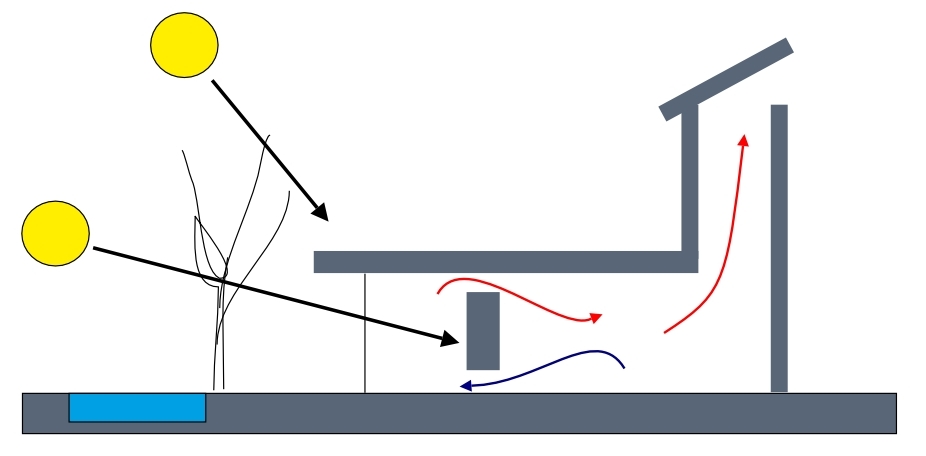Solar shading
Solar radiation can be useful in providing natural light and heat for buildings, reducing the need for artificial lighting or heating. This can reduce energy use and so emissions. However, excessive solar radiation can result in overheating, which may need to be countered with energy-intensive cooling, or can cause glare, a form of visual discomfort experienced when lighting is excessively bright.
Part L of the UK building regulations places restrictions on the amount of glazing that can be used in buildings. See also Approved document o and shading for housing, a design guide.
Solar shading, is a form of solar control that can be used to optimise the amount of solar heat gain and visible light that is admitted into a building. This can have a significant impact on the energy use of a building as well as on the thermal and visual comfort of occupants, protecting against overheating and glare on hot or sunny days. It can also provide privacy.
Solar shading can be fixed or moveable (dynamic).
Fixed solar shading can be provided by:
- Canopies.
- Overhanging eaves or balconies.
- Trees and other vegetation.
- External louvres or brise soleil.
- Light shelves.
- Canopies and awnings.
- Solar control glazing.
Dynamic solar shading can be provided by:
- Internal blinds.
- Curtains.
- Internal or external shutters.
- External roller blinds.
- Other adjustable shading devices that respond to conditions.
Under cloudy conditions, moveable shading can be retracted to allow daylight and useful solar gain to enter the buildings, reducing dependence on electric lighting and heating.
However, The way these systems are controlled can have a significant impact on building energy efficiency and on occupant comfort and wellbeing. Incorrect operation can lead to overheating and glare, or can result in a building being shaded when it does not need to be.
Dynamic solar shading can be operated manually by chords, chains and crank handles, or it can be motorised, either hard wired, battery operated or solar powered. This can make control easier and safer and can allow automation, either by timer or in response to actual conditions.
[edit] Related articles on Designing Buildings Wiki
- Angular selective shading systems.
- Automated blinds.
- Blinds.
- BREEAM Visual comfort Glare control.
- Brise soleil.
- Control of solar shading IP 4 17.
- Daylight lighting systems.
- Exterior shutters.
- Glare.
- Louvre (or louver).
- Retrofitting solar shading.
- Solar gain.
- Solar shading of buildings BR 364.
- Solar thermal panels.
- The daylight factor.
- Thermal comfort.
- Urban heat island effect.
- When hospital buildings aren’t healthy.
- Wind Resistance for External Blinds.
Featured articles and news
The UK's Modern Industrial Strategy: A 10 year plan
Previous consultation criticism, current key elements and general support with some persisting reservations.
Building Safety Regulator reforms
New roles, new staff and a new fast track service pave the way for a single construction regulator.
Architectural Technologist CPDs and Communications
CIAT CPD… and how you can do it!
Cooling centres and cool spaces
Managing extreme heat in cities by directing the public to places for heat stress relief and water sources.
Winter gardens: A brief history and warm variations
Extending the season with glass in different forms and terms.
Restoring Great Yarmouth's Winter Gardens
Transforming one of the least sustainable constructions imaginable.
Construction Skills Mission Board launch sector drive
Newly formed government and industry collaboration set strategy for recruiting an additional 100,000 construction workers a year.
New Architects Code comes into effect in September 2025
ARB Architects Code of Conduct and Practice available with ongoing consultation regarding guidance.
Welsh Skills Body (Medr) launches ambitious plan
The new skills body brings together funding and regulation of tertiary education and research for the devolved nation.
Paul Gandy FCIOB announced as next CIOB President
Former Tilbury Douglas CEO takes helm.
UK Infrastructure: A 10 Year Strategy. In brief with reactions
With the National Infrastructure and Service Transformation Authority (NISTA).
Ebenezer Howard: inventor of the garden city. Book review.
The Grenfell Tower fire, eight years on
A time to pause and reflect as Dubai tower block fire reported just before anniversary.
Airtightness Topic Guide BSRIA TG 27/2025
Explaining the basics of airtightness, what it is, why it's important, when it's required and how it's carried out.
Construction contract awards hit lowest point of 2025
Plummeting for second consecutive month, intensifying concerns for housing and infrastructure goals.
Understanding Mental Health in the Built Environment 2025
Examining the state of mental health in construction, shedding light on levels of stress, anxiety and depression.






















